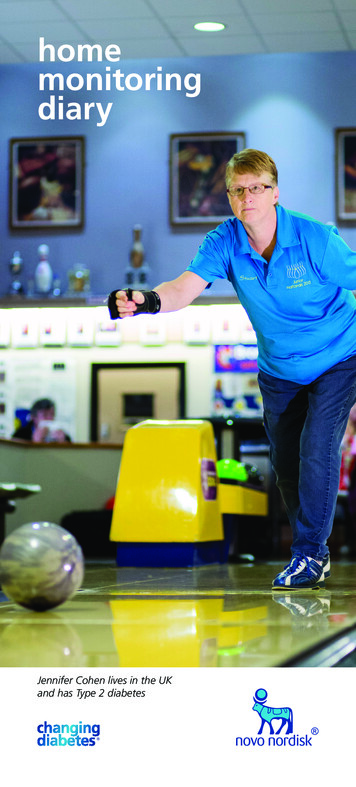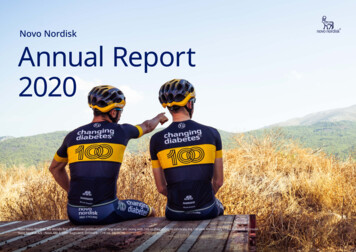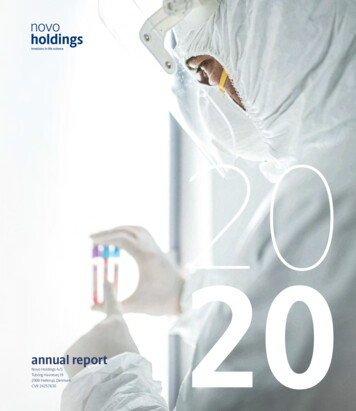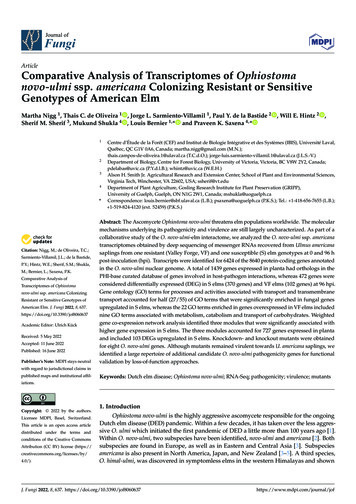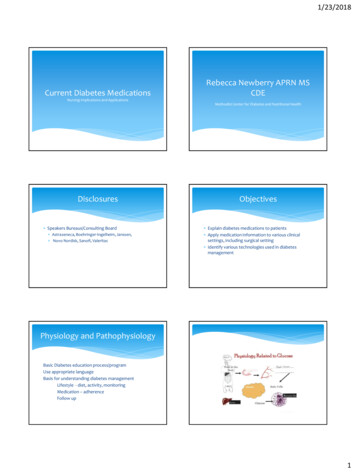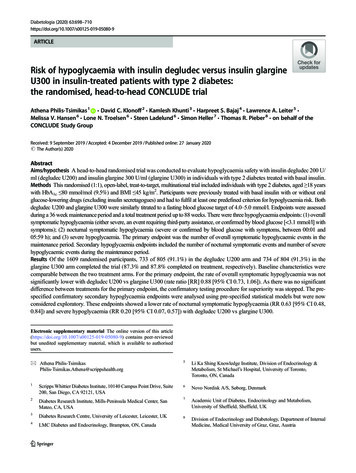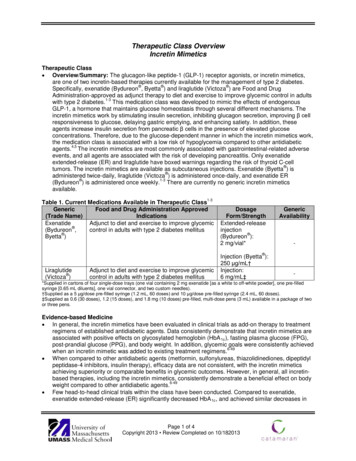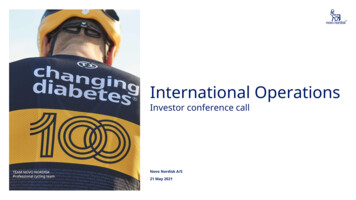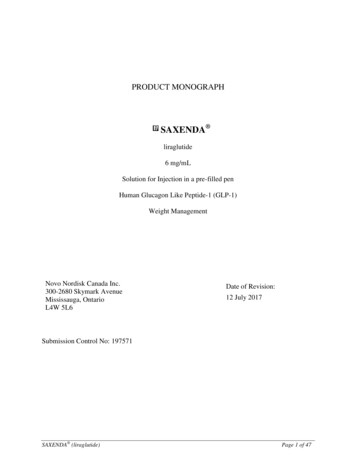
Transcription
PRODUCT MONOGRAPHSAXENDA liraglutide6 mg/mLSolution for Injection in a pre-filled penHuman Glucagon Like Peptide-1 (GLP-1)Weight ManagementNovo Nordisk Canada Inc.300-2680 Skymark AvenueMississauga, OntarioL4W 5L6Date of Revision:12 July 2017Submission Control No: 197571SAXENDA (liraglutide)Page 1 of 47
Table of ContentsPART I: HEALTH PROFESSIONAL INFORMATION . 3SUMMARY PRODUCT INFORMATION . 3DESCRIPTION. 3INDICATIONS AND CLINICAL USE . 3CONTRAINDICATIONS . 4WARNINGS AND PRECAUTIONS . 4ADVERSE REACTIONS. 9DRUG INTERACTIONS . 14DOSAGE AND ADMINISTRATION . 16OVERDOSAGE . 17ACTION AND CLINICAL PHARMACOLOGY . 18STORAGE AND STABILITY . 20SPECIAL HANDLING INSTRUCTIONS . 20DOSAGE FORMS, COMPOSITION AND PACKAGING . 20PART II: SCIENTIFIC INFORMATION . 21PHARMACEUTICAL INFORMATION. 21CLINICAL TRIALS . 21TOXICOLOGY . 29REFERENCES . 33PART III: PATIENT MEDICATION INFORMATION . 34SAXENDA (liraglutide)Page 2 of 47
SAXENDA (liraglutide)PART I: HEALTH PROFESSIONAL INFORMATIONSUMMARY PRODUCT INFORMATIONRoute ofAdministrationsubcutaneousDosage Form / StrengthInjectable, 6 mg/mLClinically Relevant NonmedicinalIngredientsDisodium phosphate dihydrate, propyleneglycol, phenol and water for injections. For acomplete listing see Dosage Forms,Composition and Packaging section.DESCRIPTIONSAXENDA contains liraglutide, an analog of human GLP-1 and acts as a GLP-1 receptoragonist. The peptide precursor of liraglutide, produced by a process that includes expression ofrecombinant DNA in Saccharomyces cerevisiae, has been engineered to be 97% homologous tonative human GLP-1 by substituting arginine for lysine at position 34. Liraglutide is made byattaching a C-16 fatty acid (palmitic acid) with a glutamic acid spacer on the remaining lysineresidue at position 26 of the peptide precursor.SAXENDA is a clear, colourless solution. Each 1 mL of SAXENDA solution contains 6 mgof liraglutide. Each pre-filled pen contains a 3 mL solution of SAXENDA equivalent to 18 mgliraglutide (free-base, anhydrous).INDICATIONS AND CLINICAL USESAXENDA (liraglutide) is indicated as an adjunct to a reduced calorie diet and increasedphysical activity for chronic weight management in adult patients with an initial body mass index(BMI) of: 30 kg/m2 or greater (obese), or 27 kg/m2 or greater (overweight) in the presence of at least one weight-relatedcomorbidity (e.g., hypertension, type 2 diabetes, or dyslipidemia) and who have failed aprevious weight management intervention.Limitation of Use:1. Clinical efficacy and safety data from patients with BMI 27 to 29.9 kg/m2 in the presenceof at least one weight-related comorbid condition (e.g. hypertension, type 2 diabetesmellitus, or dyslipidemia) are limited (N 149).Geriatrics ( 65 years of age): Patients 65 years may experience more gastrointestinal sideeffects when treated with SAXENDA . Therapeutic experience in patients 75 years of age isvery limited.No overall differences in safety or effectiveness were observed between these patients andyounger patients, but greater sensitivity of some older individuals cannot be ruled out. (See:SAXENDA (liraglutide)Page 3 of 47
WARNINGS AND PRECAUTIONS, Special Populations, Geriatrics).Pediatrics ( 18 years of age): The safety and efficacy of SAXENDA have not been studied inpediatric populations. SAXENDA is not indicated for use in pediatric patients (seeWARNINGS AND PRECAUTIONS, Special Population, Pediatrics).CONTRAINDICATIONS In patients with a personal or family history of medullary thyroid carcinoma or in patientswith Multiple Endocrine Neoplasia syndrome type 2 (MEN 2), (see WARNINGS ANDPRECAUTIONS, Malignancies). Patients who are hypersensitive to liraglutide or to any ingredient in the formulation. Fora complete listing, (see DOSAGE FORMS, COMPOSITION AND PACKAGING). During pregnancy or in breast-feeding women, (see WARNINGS ANDPRECAUTIONS, Special populations).WARNINGS AND PRECAUTIONSSerious Warnings and PrecautionsRisk of Thyroid C-cell TumoursLiraglutide causes dose-dependent and treatment-duration-dependent thyroid C-cell tumours atclinically relevant exposures in both genders of rats and mice (see PART II, ToxicologySection). It is unknown whether liraglutide causes thyroid C-cell tumours, including medullarythyroid carcinoma (MTC), in humans, as human relevance could not be ruled out by clinical ornonclinical studies.SAXENDA is contraindicated in patients with a personal or family history of MTC and inpatients with Multiple Endocrine Neoplasia syndrome type 2 (MEN 2). Based on the findingsin rodents, monitoring with serum calcitonin or thyroid ultrasound was performed duringclinical trials, but this may have increased the number of unnecessary thyroid surgeries. It isunknown whether monitoring with serum calcitonin or thyroid ultrasound will mitigate humanrisk of thyroid C-cell tumours. Patients should be counselled regarding the risk and symptomsof thyroid tumours (see Contraindications, Warnings and Precautions, Adverse DrugReactions and Toxicology).GeneralThe safety and effectiveness of SAXENDA in combination with other products intended forweight loss, including prescription drugs, over-the-counter drugs and herbal preparations, havenot been established.SAXENDA should not be administered intravenously or intramuscularly.Never Share a SAXENDA pen Between Patients.SAXENDA pen should never be shared between patients, even if the needle if changed. Sharingposes a risk for transmission of blood-borne pathogens.SAXENDA (liraglutide)Page 4 of 47
CardiovascularThe effects of SAXENDA on cardiovascular morbidity and mortality have not been established.Increase in Heart Rate: In the clinical trials, mean increases in resting heart rate of 2 to 3 beatsper minute (bpm) were observed with routine clinical monitoring in SAXENDA -treatedpatients compared to placebo. More patients treated with SAXENDA , compared with placebo,have changes from baseline at two consecutive visits of more than 10 bpm (34% versus 19%,respectively) and 20 bpm (5% versus 2%, respectively). At least one resting heart rate exceeding100 bpm was recorded for 6% of SAXENDA -treated patients compared with 4% of placebotreated patients, with this occurring at two consecutive study visits for 0.9% and 0.3%,respectively. Tachycardia was reported as an adverse reaction in 0.6% of SAXENDA -treatedpatients and in 0.1% of placebo-treated patients.In a clinical pharmacology trial that monitored heart rate continuously for 24 hours, SAXENDA treatment was associated with a heart rate that was 4 to 9 bpm higher than that observed withplacebo. (See ADVERSE REACTIONS, QTc in healthy Volunteers).The clinical significance of the heart rate elevation with SAXENDA treatment is unclear,especially for patients with cardiac and cerebrovascular disease as a result of limited exposure inthese patients in clinical trials.Heart rate should be monitored at regular intervals consistent with usual clinical practice.Patients should inform their healthcare professional of palpitations or feelings of a racingheartbeat while at rest during SAXENDA treatment. For patients who experience a sustainedincrease in resting heart rate while taking SAXENDA , SAXENDA should be discontinued.PR Interval Prolongation: A prolongation of the mean PR interval of up to 10 ms was reportedwith SAXENDA treatment in a clinical trial in healthy volunteers, using lower doses thanrecommended for weight management (see ADVERSE REACTIONS QTc in healthyvolunteers). In healthy volunteers and in patients with overweight or obesity, the incidence offirst degree atrioventricular (AV) block was higher with SAXENDA than with placebo (seeADVERSE REACTIONS, Cardiovascular disorders). The clinical significance of these changesis not fully known; however, because of limited clinical experience in patients with pre-existingconduction system abnormalities (e.g., marked first-degree AV block or second- or third-degreeAV block) and heart rhythm disturbances (e.g., tachyarrhythmia), caution should be observed inthese patients (see DRUG INTERACTIONS).Endocrine and MetabolismHypoglycemia: Severe hypoglycemia was observed in clinical trials in patients with type 2diabetes mellitus treated with SAXENDA . The risk of hypoglycemia may be lowered by areduction in the dose of concomitantly administered insulin secretagogues (such assulfonylureas). (See ADVERSE REACTIONS, Clinical Trial Adverse Drug Reaction).SAXENDA and insulin should not be used together. SAXENDA has not been studied inpatients taking insulin.Hepatic/Biliary/PancreasSAXENDA (liraglutide)Page 5 of 47
Acute Pancreatitis: Based on spontaneous post-marketing reports, acute pancreatitis, includingfatal and non-fatal hemorrhagic or necrotizing pancreatitis has been observed in patients treatedwith liraglutide. After initiation of SAXENDA , observe patients carefully for signs andsymptoms of pancreatitis (including persistent or intermittent severe abdominal pain, sometimesradiating to the back and which may or may not be accompanied by vomiting). If pancreatitis issuspected, SAXENDA should promptly be discontinued, confirmatory tests should beperformed and appropriate management should be initiated. If pancreatitis is confirmed,SAXENDA should not be restarted.In SAXENDA clinical trials, acute pancreatitis was confirmed by adjudication in 9 (0.3%) of3291 SAXENDA -treated patients and 2 (0.1%) of 1843 placebo-treated patients. In addition,there were 2 cases of acute pancreatitis in SAXENDA -treated patients who prematurelywithdrew from these clinical trials, occurring 74 and 124 days after the last dose There were twoadditional cases in a SAXENDA -treated patients. One during an off-treatment follow-upperiod within 2 weeks of discontinuing SAXENDA and one that occurred in a patient whocompleted treatment and was off-treatment for 106 days.It is unknown whether patients with a history of pancreatitis are at increased risk for pancreatitiswhile using SAXENDA , since these patients were excluded from clinical trials.Acute Gallbladder Disease: In SAXENDA clinical trials, 2.2% of SAXENDA -treatedpatients reported adverse events of cholelithiasis versus 0.8% of placebo-treated patients. Theincidence of cholecystitis was 0.8% in SAXENDA -treated patients versus 0.4% in placebotreated patients. The majority of SAXENDA -treated patients with adverse events ofcholelithiasis and cholecystitis required cholecystectomy. Substantial or rapid weight loss canincrease the risk of cholelithiasis; however, the incidence of acute gallbladder disease wasgreater in SAXENDA -treated patients than in placebo-treated patients even after accounting forthe degree of weight loss. If cholelithiasis is suspected, gallbladder studies and appropriateclinical follow-up are indicated.ImmuneHypersensitivity Reactions: There have been reports of serious hypersensitivity reactions (e.g.,anaphylactic reactions and angioedema) in patients treated with SAXENDA (see ADVERSEREACTIONS, Clinical Trial Adverse Drug Reactions). If a hypersensitivity reaction occurs, thepatient should discontinue SAXENDA and other suspect medications and promptly seekmedical advice.Angioedema has also been reported with other GLP-1 receptor agonists. Use caution in a patientwith a history of angioedema with another GLP-1 receptor agonist because it is unknownwhether such patients will be predisposed to angioedema with SAXENDA .MalignanciesRisk of Thyroid C-Cell Tumours: SAXENDA causes dose-dependent and treatment-durationdependent thyroid C-cell tumours (adenomas and/or carcinomas) at clinically relevant exposuresin both genders of rats and mice (see PART II, TOXICOLOGY). Malignant thyroid C-cellcarcinomas were detected in rats and mice. A statistically significant increase in cancer wasSAXENDA (liraglutide)Page 6 of 47
observed in rats receiving liraglutide at 10-times clinical exposure compared to controls. It isunknown whether SAXENDA will cause thyroid C-cell tumours, including medullary thyroidcarcinoma (MTC) in humans, as the human relevance of liraglutide-induced rodent thyroid Ccell tumours could not be determined by clinical or nonclinical studies.Calcitonin, a biological marker of MTC, was measured throughout the SAXENDA clinicaldevelopment program. In the clinical trials, there was one reported case of thyroid C-cellhyperplasia among SAXENDA -treated patients and no cases in placebo-treated patients. In thecase of the thyroid C-cell hyperplasia, the patient had elevated blood calcitonin level atscreening. There were no cases of MTC in SAXENDA -treated patients and one case inplacebo-treated patients.Counsel patients regarding the risk for MTC and the symptoms of thyroid tumours (e.g., a massin the neck, dysphagia, dyspnea or persistent hoarseness). It is unknown whether monitoring withserum calcitonin or thyroid ultrasound will mitigate the potential risk of MTC, and suchmonitoring may increase the risk of unnecessary procedures, due to low test specificity for serumcalcitonin and a high background incidence of thyroid disease. Patients with thyroid nodulesnoted on physical examination or neck imaging obtained for other reasons should be referred toan endocrinologist for further evaluation. Although routine monitoring of serum calcitonin is ofuncertain value in patients treated with SAXENDA , if serum calcitonin is measured and foundto be elevated, the patient should be referred to an endocrinologist for further evaluation.Patients with MTC usually have calcitonin values 50 ng/L.Breast neoplasms: In SAXENDA clinical trials, more cases of breast cancer were observedamong patients receiving SAXENDA compared to control patients (see ADVERSEREACTIONS, Clinical Trial Adverse Drug Reaction).PsychiatricSuicidal Behavior and Ideation: In SAXENDA clinical trials, 9 (0.3%) of 3384 SAXENDA treated patients and 2 (0.1%) of the 1941 placebo-treated patients reported suicidal ideation; oneof these SAXENDA -treated patients attempted suicide. Patients treated with SAXENDA should be monitored for the emergence or worsening of depression, suicidal thoughts orbehavior, and/or any unusual changes in mood or behavior. Discontinue SAXENDA in patientswho experience suicidal thoughts or behaviors. Avoid SAXENDA in patients with a history ofsuicidal attempts or active suicidal ideation.Special PopulationsCardiovascular - Patients with recent Myocardial Infarction, Unstable Angina andCongestive Heart Failure: In clinical trials of SAXENDA , subjects with clinically significantheart disease, acute myocardial infarction within 6 months, unstable angina pectoris andcongestive heart failure (NYHA, class III to IV) were not studied. Therefore, SAXENDA should be used with caution in this population.Hepatic Insufficiency: The safety and efficacy of SAXENDA in patients with hepaticinsufficiency has not been studied. The use of SAXENDA in patients with hepatic insufficiencyis not recommended.SAXENDA (liraglutide)Page 7 of 47
Renal Insufficiency: There is limited experience with SAXENDA in patients with moderaterenal insufficiency. Patients with moderate renal insufficiency may experience more fatigue andgastrointestinal adverse reactions. Gastrointestinal adverse reactions were the most commonadverse reaction leading to discontinuation of treatment. There is very limited or no clinicalexperience in patients with severe renal insufficiency, including end-stage renal disease; use inthese patients is not recommended.Patients treated with SAXENDA should be advised of the potential risk of dehydration inrelation to gastrointestinal side effects and take precautions to avoid fluid depletion. Renalimpairment has been reported, usually in association with nausea, vomiting, diarrhea, ordehydration which may sometimes require hemodialysis. Use caution when initiating orescalating doses of SAXENDA in patients with renal insufficiency (see ADVERSEREACTIONS).Gastrointestinal Disease: The use of SAXENDA is associated with transient gastrointestinaladverse reactions; including nausea, vomiting, and diarrhea (see ADVERSE REACTIONS,Adverse Drug Reaction Overview and Clinical Trial Adverse Drug Reactions, Gastrointestinaladverse events). The safety of SAXENDA in subjects with inflammatory bowel disease anddiabetic gastroparesis has not been studied. SAXENDA should not be used in this population.Pregnant Women: SAXENDA is contraindicated during pregnancy. Weight loss offers nobenefit to a pregnant woman and may result in fetal harm. A minimum weight gain, and noweight loss, is recommended for all pregnant women, including those who are alreadyoverweight or obese, due to the necessary weight gain that occurs in maternal tissues duringpregnancy.There have been no studies conducted in pregnant women with SAXENDA . In SAXENDA clinical trials, a greater proportion of reported pregnancies resulted in spontaneous abortionamongst women taking SAXENDA (9 of 31 pregnancies) than placebo (2 of 15 pregnancies).Studies in animals have shown reproductive and developmental toxicity, includingteratogenicity, at or above 0.9 times the clinical exposure (see PART II: TOXICOLOGY).SAXENDA should not be used during pregnancy (see CONTRAINDICATIONS). If a patientwishes to become pregnant or pregnancy occurs, treatment with SAXENDA should bediscontinued.Nursing Women: It is not known whether SAXENDA is excreted in human milk. In lactatinganimals SAXENDA was excreted unchanged in milk. Because many drugs are excreted inhuman milk and because of the potential for tumorigenicity shown for liraglutide in animalstudies, women who are nursing should discontinue SAXENDA treatment. (See PART II:TOXICOLOGY)Pediatrics ( 18 years of age): The safety and efficacy of SAXENDA in pediatric patients havenot been studied. SAXENDA is not indicated for use in pediatric patients.SAXENDA (liraglutide)Page 8 of 47
Geriatrics ( 65 years of age): In the SAXENDA clinical trials, 232 (6.9%) of theSAXENDA -treated patients were 65 years of age and over, and 17 (0.5%) of the SAXENDA treated patients were 75 years of age and over. Patients 65 years may experience moregastrointestinal side effects when treated with SAXENDA . No overall differences in safety oreffectiveness were observed between these patients and younger patients, but greater sensitivityof some older individuals cannot be ruled out.ADVERSE REACTIONSAdverse Drug Reaction OverviewDuring the main treatment period of the weight management studies, serious adverse events wereboth more common with SAXENDA (6.3% vs. 4.6%), and led to withdrawal more often (1.2%vs. 0.7%), compared to placebo.In controlled clinical trials, 9.8% of patients treated with SAXENDA and 4.3% of patientstreated with placebo prematurely discontinued treatment due to adverse reactions. The mostcommon adverse reactions (occurring in 1% of SAXENDA treated patients) leading todiscontinuation were nausea (2.9% in SAXENDA vs. 0.2% in placebo), vomiting (1.7% vs. 0.1%), and diarrhea (1.4% vs. 0%).Clinical Trial Adverse Drug ReactionsBecause clinical trials are conducted under very specific conditions, the adverse reaction ratesobserved in the clinical trials may not reflect the rates observed in practice and should not becompared to the rates in the clinical trials of another drug. Adverse drug reaction informationfrom clinical trials is useful for identifying drug-related adverse events and for approximatingrates.The data below reflect exposure to SAXENDA in four randomized, double-blind, placebocontrolled, multicenter Phase 3 clinical trials, one of 32-weeks duration and three of 56-weeksduration; and one Phase 2 supportive trial in 469 adult patients. In these trials, patients receivedSAXENDA for a mean treatment duration of 45.9 weeks (median, 55.9 weeks).In one 56-week trial, patients with abnormal glucose measurements at randomization wereenrolled into a 160-week period (with a 12-week off-treatment follow-up) of the trial [seeClinical Trials, Study demographics and trial design]. For the 160-week period of the trial,patients who had abnormal glucose measurements at randomization received SAXENDA for amean treatment duration of 109.9 weeks (median, 159.3 weeks). In addition to the adversereactions which have been identified in Table 1, the following adverse reactions occurred in 1%and more frequently in SAXENDA -treated patients than in placebo-treated patients:gastroenteritis, urinary tract infection, gastroenteritis viral, cystitis, tonsillitis, diverticulitis, noncardiac chest pain, musculoskeletal pain, and intervertebral disc protrusion.Adverse reactions reported in greater than or equal to 1% of SAXENDA -treated patients andmore frequently than in the placebo group are shown in Table 1.Table 1 Adverse Reactions Reported in Greater Than or Equal to 1% for Patients onSAXENDA and More Frequently than in Placebo Patients.SAXENDA (liraglutide)Page 9 of 47
System Organ ClassPreferred TermGastrointestinal iaAbdominal PainAbdominal Pain UpperAbdominal distensionEructationFlatulenceGastroesophageal Reflux DiseaseDry MouthGastritisMetabolism and Nutrition DisordersHypoglycemia*Decreased AppetiteGeneral Disorders and AdministrationSite ConditionsInjection site erythemaInjection site reactionsInjection site pruritusInjection site rashFatigueAstheniaNervous System DisordersDizzinessDysgeusiaInvestigationsIncreased lipaseIncreased amylasePsychiatric disordersInsomnia**Hepatobiliary DisordersCholelithiasisSAXENDA PlaceboN 3384N 1941n (%)n (%)Baseline to up to Week 56 of treatment1329 (39.3)707 (20.9)658 (19.4)530 (15.7)326 (9.6)182 (5.4)172 (5.1)151 (4.5)151 (4.5)136 (4.0)159 (4.7)77 (2.3)48 (1.4)267 (13.8)192 (9.9)165 (8.5)75 (3.9)53 (2.7)60 (3.1)53 (2.7)58 (3.0)4 (0.2)49 (2.5)33 (1.7)19 (1.0)22 (1.1)46 (1.6)337 (10.0)19 (1.1)45 (2.3)86 (2.5)86 (2.5)43 (1.3)36 (1.1)254 (7.5)70 (2.1)4 (0.2)11 (0.6)4 (0.2)2 (0.1)89 (4.6)15 (0.8)233 (6.9)53 (1.6)97 (5.0)15 (0.8)178 (5.3)47 (1.4)43 (2.2)13 (0.7)80 (2.4)33 (1.7)51 (1.5)10 (0.5)*Hypoglycemia (based on self-reported symptoms by patients and not confirmed by blood glucose measurements) reported in patients withouttype 2 diabetes mellitus treated with SAXENDA in combination with diet and exercise. Please see below for further information regardinghypoglycemia.**Mainly seen during the first 3 months of treatmentMalignanciesBreast CancerIn SAXENDA clinical trials, breast cancer confirmed by adjudication was reported in 17(0.7%) of 2379 SAXENDA - treated women compared with 3 (0.2%) of 1300 placebo-treatedwomen, including invasive cancer (13 SAXENDA - and 2 placebo-treated women) and ductalcarcinoma in situ (4 SAXENDA - and 1 placebo-treated woman). The majority of cancers wereestrogen- and progesterone-receptor positive. There were too few cases to determine whetherthese cases were related to SAXENDA . In addition, there are insufficient data to determineSAXENDA (liraglutide)Page 10 of 47
whether SAXENDA has an effect on pre-existing breast neoplasia. (see WARNINGS ANDPRECAUTIONS, Malignancies, Breast neoplasms)Papillary Thyroid CancerIn SAXENDA clinical trials, papillary thyroid carcinoma confirmed by adjudication wasreported in 8 (0.2%) of 3291 SAXENDA -treated patients compared with no cases among 1843placebo-treated patients. Four of these papillary thyroid carcinomas were less than 1 cm ingreatest diameter and 4 were diagnosed in surgical pathology specimens after thyroidectomyprompted by findings identified prior to treatment (see WARNINGS AND PRECAUTIONS,Serious Warnings and Precautions, Risk of Thyroid C-Cell Tumours, Malignancies).Colorectal NeoplasmsIn SAXENDA clinical trials, benign colorectal neoplasms (mostly colon adenomas) confirmedby adjudication were reported in 20 (0.6%) of 3291 SAXENDA -treated patients compared with7 (0.4%) of 1843 placebo-treated patients. Six positively adjudicated cases of malignantcolorectal carcinoma were reported in 5 SAXENDA -treated patients (0.2%) and 1 in a placebotreated patients (0.1%).Cardiovascular disordersHeart rate increase(See WARNINGS AND PRECAUTIONS, Cardiovascular disorders).TachycardiaIn SAXENDA clinical trials, tachycardia was reported in 0.6% of SAXENDA -treated patientsand in 0.1% of placebo-treated patients. The majority of events were mild or moderate. Eventswere isolated and majority resolved during continued treatment with SAXENDA .Cardiac Conduction DisordersIn SAXENDA clinical trials, 11 (0.3%) of 3384 SAXENDA -treated patients compared withnone of the 1941 placebo-treated patients had a cardiac conduction disorder, reported as firstdegree atrioventricular block, right bundle branch block, or left bundle branch block (seeWARNINGS AND PRECAUTIONS, Cardiovascular disorders).PR Interval Prolongation(See WARNINGS AND PRECAUTIONS, Cardiovascular disorders).Major Adverse Cardiovascular EventsMajor adverse cardiovascular events (MACE) were adjudicated and defined as non-fatalmyocardial infarction, non-fatal stroke and cardiovascular death. In the clinical trials there were8 (1.54 events per 1000 patient-years) confirmed MACE for SAXENDA -treated patients and 10(3.83 events per 1000 patient years) confirmed MACE for placebo-treated patients. The hazardratio and 95% CI is 0.42 [0.17; 1.08] for SAXENDA versus placebo. Because of the lownumber of MACE, interpretation should be done with caution.Cardiac Electrophysiology (QTc) in healthy volunteersSAXENDA (liraglutide)Page 11 of 47
The effect of liraglutide on cardiac repolarization was tested in a QTc study. Liraglutide at steadystate concentrations with daily doses up to 1.8 mg did not produce QTc prolongation. Theliraglutide exposure for overweight and obese subjects treated with liraglutide 3.0 mg iscomparable to the exposure evaluated in the liraglutide QTc study in healthy volunteers.Hypoglycemia in patients without type 2 diabetes mellitusIn SAXENDA clinical trials in overweight or obese patients without type 2 diabetes mellitus,there were no events of hypoglycemia that required the assistance of another person.Hypoglycemic events (based on self-reported symptoms by patients and not confirmed by bloodglucose measurements) were reported in 1.6 % of SAXENDA -treated patients and 1.1% ofplacebo-treated patients. The majority of the events were mild.Hypoglycemia in patients with type 2 diabetes mellitusIn a SAXENDA clinical trial in overweight or obese patients with type 2 diabetes mellitus,hypoglycemia requiring the assistance of another person occurred in 3 (0.7%) SAXENDA treated patients and in no placebo-treated patients. Of these 3 SAXENDA -treated patients, allwere concomitantly using a sulfonylurea. In patients concomitantly using a sulfonylurea,hypoglycemia defined as blood sugar less than or equal to 3.9 mmol/L and with documentedsymptoms occurred in 48 (43.6%) SAXENDA -treated patients and 15 (27.3%) placebo-treatedpatients. In patients not concomitantly using a sulfonylurea, hypoglycemia was reported in 49(15.7%) SAXENDA -patients and 12 (7.6%) placebo-treated patients.Gastrointestinal adverse eventsGastrointestinal adverse events (AEs) were the most frequently reported AEs during treatmentwith SAXENDA (67.9% vs. 39.3% with placebo) and were more often severe (4.8% vs. 1.4%with placebo) and led to withdrawal more often (6.2% vs. 0.8% with placebo).The most frequently reported gastrointestinal AE was nausea (39% and 14% of patients treatedwith SAXENDA and placebo, respectively). The percentage of patients reporting nauseadeclined as treatment continued. Other common adverse reactions that occurred at a higherincidence among SAXENDA -treated patients included diarrhea, constipation, vomiting,dyspepsia, abdominal pain, dry mouth, gastritis, gastroesophageal reflux disease, flatulence,eructation and abdominal distension. Most episodes of gastrointestinal events were mild ormoderate and did not lead to discontinuation of therapy. There have been reports ofgastrointestinal AEs, such as nausea, vomiting, and diarrhea, associated with volume depletionand renal insufficiency (see WARNINGS AND PRECAUTIONS, Gastrointestinal Disease).Asthenia, Fatigue, Malaise, Dysgeusia and DizzinessEvents of asthenia, fatigue, malaise, dysgeusia and dizziness were mainly reported within thefirst 12 weeks of tr
, compared with placebo, have changes from baseline at two consecutive visits of more than 10 bpm (34% versus 19%, respectively) and 20 bpm (5% versus 2%, respectively). At least one resting heart rate exceeding 100 bpm was recorded for 6% of SAXENDA

